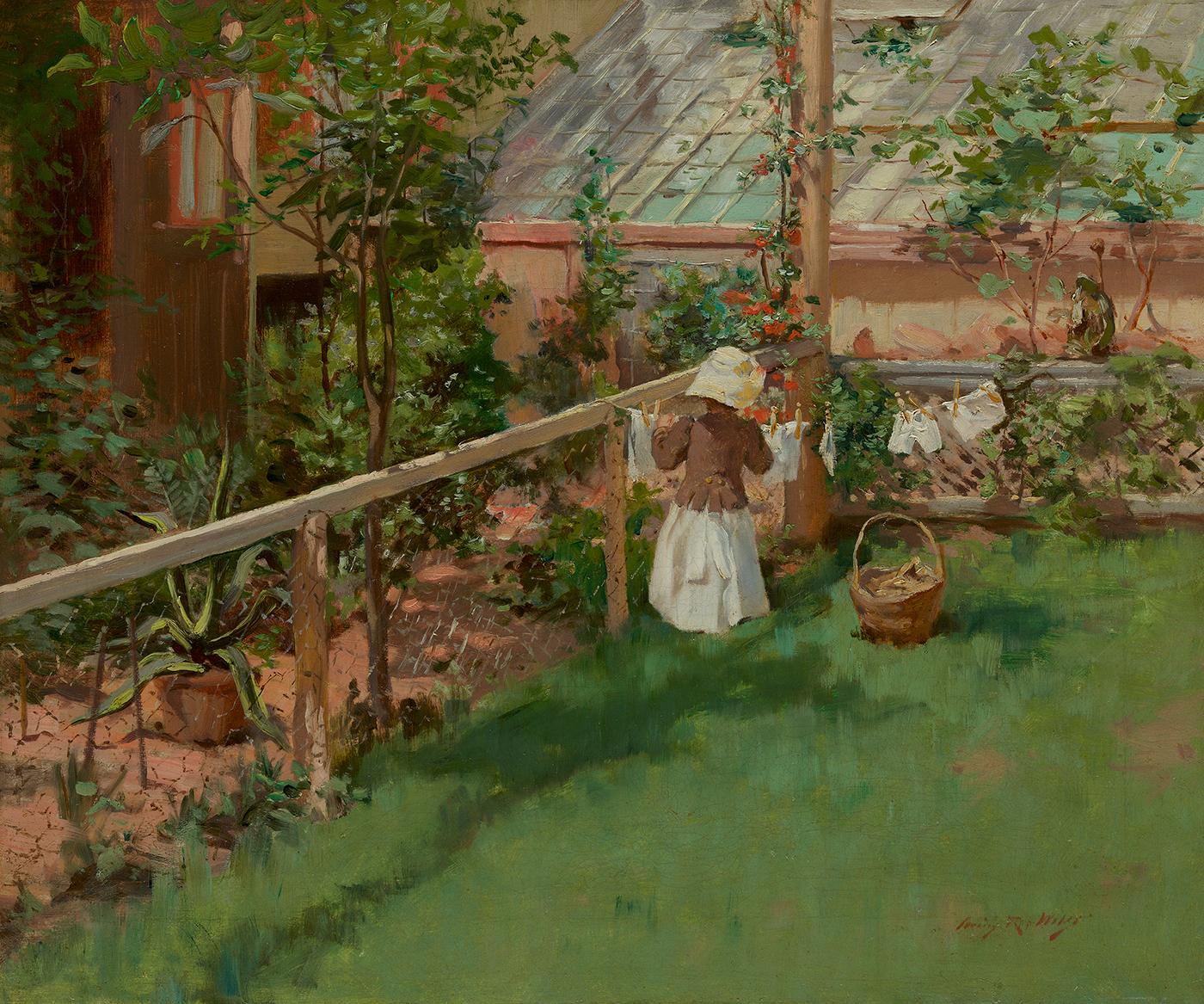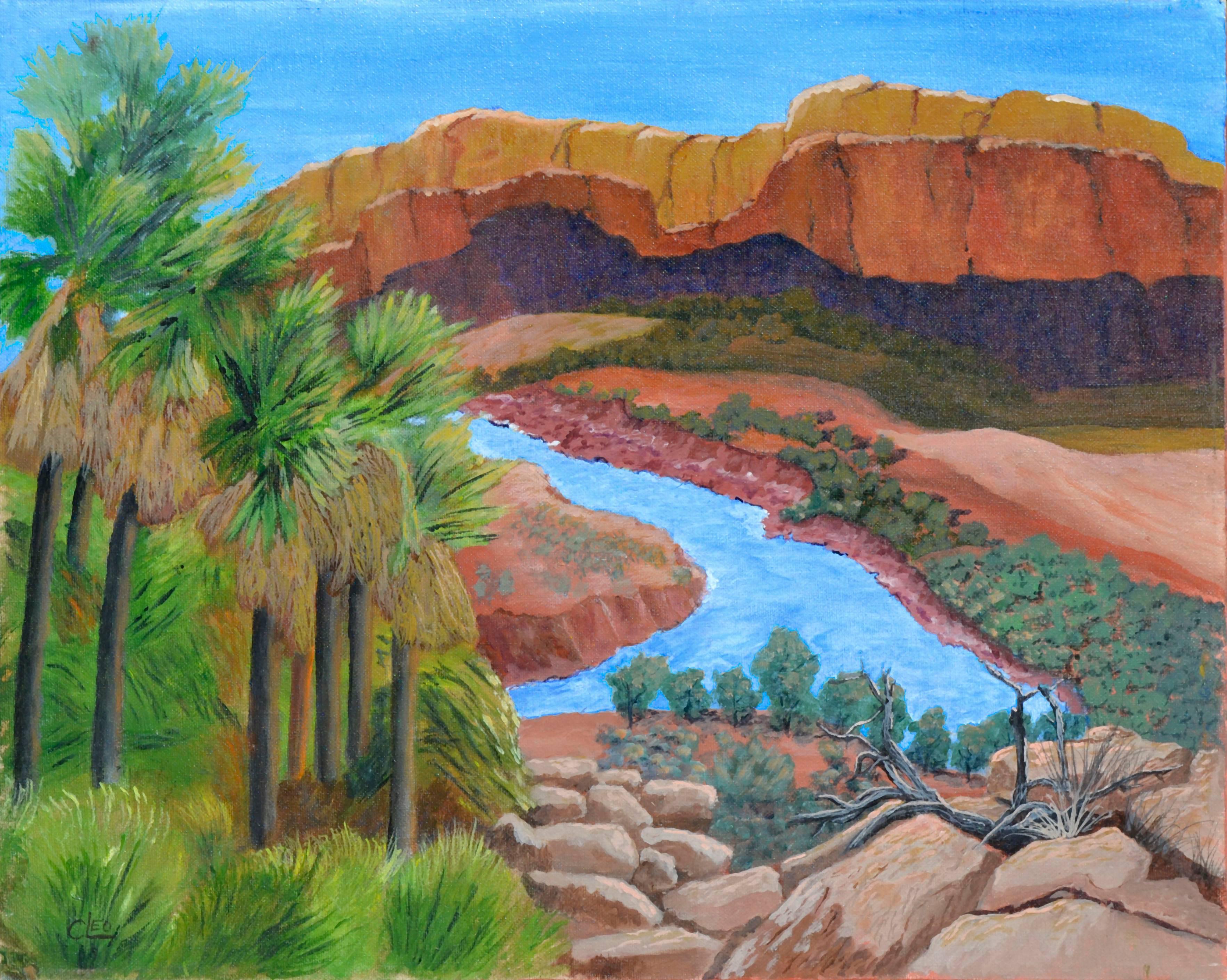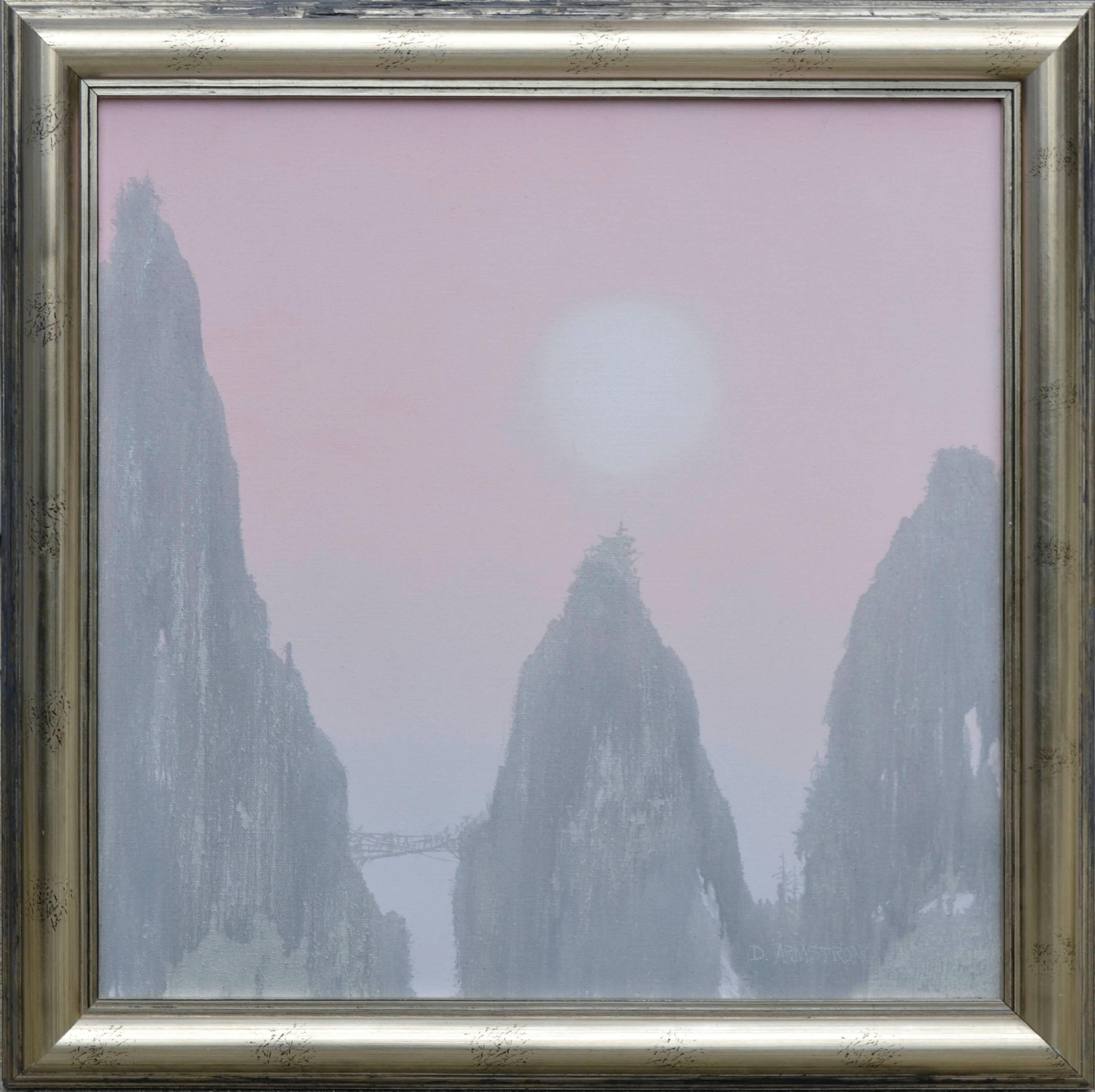Items Similar to "Fields in Jersey"
Want more images or videos?
Request additional images or videos from the seller
1 of 6
Daniel Garber"Fields in Jersey"c. 1909
c. 1909
About the Item
Jim’s of Lambertville Fine Art Gallery is proud to present this piece by Daniel Garber (1880 - 1958).
One of the two most important and, so far, the most valuable of the New Hope School Painters, Daniel Garber was born on April 11, 1880, in North Manchester, Indiana. At the age of seventeen, he studied at the Art Academy of Cincinnati with Vincent Nowottny. Moving to Philadelphia in 1899, he first attended classes at the "Darby School," near Fort Washington; a summer school run by Academy instructors Anshutz and Breckenridge. Later that year, he enrolled at the Pennsylvania Academy of the Fine Arts. His instructors at the Academy included Thomas Anshutz, William Merritt Chase and Cecilia Beaux. There Garber met fellow artist Mary Franklin while she was posing as a model for the portrait class of Hugh Breckenridge. After a two year courtship, Garber married Mary Franklin on June 21, 1901.
In May 1905, Garber was awarded the William Emlen Cresson Scholarship from the Pennsylvania Academy, which enabled him to spend two years for independent studies in England, Italy and France. He painted frequently while in Europe, creating a powerful body of colorful impressionist landscapes depicting various rural villages and farms scenes; exhibiting several of these works in the Paris Salon.
Upon his return, Garber began to teach Life and Antique Drawing classes at the Philadelphia School of Design for Women in 1907. In the summer of that same year, Garber and family settled in Lumbertville, Pennsylvania, a small town just north of New Hope. Their new home would come to be known as the "Cuttalossa," named after the creek which occupied part of the land. The family would divide the year, living six months in Philadelphia at the Green Street townhouse while he taught, and the rest of the time in Lambertville. Soon Garber’s career would take off as he began to receive a multitude of prestigious awards for his masterful Pennsylvania landscapes. During the fall of 1909, he was offered a position to teach at the Pennsylvania Academy as an assistant to Thomas Anshutz. Garber became an important instructor at the Academy, where he taught for forty-one years.
Daniel Garber painted masterful landscapes depicting the Pennsylvania and New Jersey countryside surrounding New Hope. Unlike his contemporary, Edward Redfield, Garber painted with a delicate technique using a thin application of paint. His paintings are filled with color and light projecting a feeling of endless depth. Although Like Redfield, Garber painted large exhibition size canvases with the intent of winning medals, and was extremely successful doing so, he was also very adept at painting small gem like paintings. He was also a fine draftsman creating a relatively large body of works on paper, mostly in charcoal, and a rare few works in pastel. Another of Garber’s many talents was etching. He created a series of approximately fifty different scenes, most of which are run in editions of fifty or less etchings per plate.
Throughout his distinguished career, Daniel Garber was awarded some of the highest honors bestowed upon an American artist. Some of his accolades include the First Hallgarten Prize from the National Academy in 1909, the Bronze Medal at the International Exposition in Buenos Aires in 1910, the Walter Lippincott Prize from the Pennsylvania Academy and the Potter Gold Medal at the Art Institute of Chicago in 1911, the Second Clark Prize and the Silver Medal from the Corcoran Gallery of Art for “Wilderness” in 1912, the Gold Medal from the Panama-Pacific Exposition in San Francisco of 1915, the Second Altman Prize in1915, the Shaw prize in 1916, the First Altman Prize in 1917, the Edward Stotesbury Prize in1918, the Temple Gold Medal, in 1919, the First William A. Clark Prize in 1921, the Gold Medal from the Philadelphia Art Club in 1923, the Carnegie Institute Bronze Medal in 1924, the Gold Medal of Honor in 1929, the Jenny Sesnan Gold Medal in 1937, the Pennell Medal in 1942, and the Pennsylvania Academy Fellowship Award in1947 among many others.
Daniel Garber and Edward Redfield are known by most art enthusiasts as the two leading figures associated with the New Hope Art Colony. This is a correct assessment, but in the broader scope, as key figures in twentieth century American Art, their importance is equally paramount. As this group, once considered regional, secures it’s place in history, painters like Garber and Redfield are destined to be considered the true American Masters by the international art world.
Garber's work is included in nearly thirty museum collections nationally and this number is growing. He is also the first of the "New Hope School" painters to exceed the million dollar mark at auction which occurred in 2003.
- Creator:Daniel Garber (1880-1958, American)
- Creation Year:c. 1909
- Dimensions:Height: 36 in (91.44 cm)Width: 44 in (111.76 cm)
- Medium:
- Movement & Style:
- Period:
- Condition:
- Gallery Location:Lambertville, NJ
- Reference Number:
About the Seller
5.0
Vetted Seller
These experienced sellers undergo a comprehensive evaluation by our team of in-house experts.
Established in 1997
1stDibs seller since 2014
Typical response time: 6 hours
- ShippingRetrieving quote...Ships From: Lambertville, NJ
- Return PolicyThis item cannot be returned.
More From This SellerView All
- "The Canal"By Edward Willis RedfieldLocated in Lambertville, NJJim’s of Lambertville is proud to offer this artwork. Signed lower left. Complemented by a hand carved and gilt frame. Illustrated in "Edward Redfield: Just Values and Fine Seeing" by Constance Kimmerle and the Pennsylvania Academy of the Fine Arts's Exhibition of Paintings by Edward Redfield (April 17 to May 16, 1909) brochure Edward Willis Redfield (1869 - 1965) Edward W. Redfield was born in Bridgeville, Delaware, moving to Philadelphia as a young child. Determined to be an artist from an early age, he studied at the Spring Garden Institute and the Franklin Institute before entering the Pennsylvania Academy from 1887 to 1889, where he studied under Thomas Anshutz, James Kelly, and Thomas Hovenden. Along with his friend and fellow artist, Robert Henri, he traveled abroad in 1889 and studied at the Academie Julian in Paris under William Bouguereau and Tony Robert-Fleury. While in France, Redfield met Elise Deligant, the daughter of an innkeeper, and married in London in 1893. Upon his return to the United States, Redfield and his wife settled in Glenside, Pennsylvania. He remained there until 1898, at which time he moved his family to Center Bridge, a town several miles north of New Hope along the Delaware River. Redfield painted prolifically in the 1890s but it was not until the beginning of the twentieth century that he would develop the bold impressionist style that defined his career. As Redfield’s international reputation spread, many young artists gravitated to New Hope as he was a great inspiration and an iconic role model. Edward Redfield remained in Center Bridge throughout his long life, fathering his six children there. Around 1905 and 1906, Redfield’s style was coming into its own, employing thick vigorous brush strokes tightly woven and layered with a multitude of colors. These large plein-air canvases define the essence of Pennsylvania Impressionism. By 1907, Redfield had perfected his craft and, from this point forward, was creating some of his finest work. Redfield would once again return to France where he painted a small but important body of work between 1907 and 1908. While there, he received an Honorable Mention from the Paris Salon for one of these canvases. In 1910 he was awarded a Gold Medal at the prestigious Buenos Aires Exposition and at the Panama-Pacific Exposition of 1915 in San Francisco, an entire gallery was dedicated for twenty-one of his paintings. Since Redfield painted for Exhibition with the intent to win medals, his best effort often went into his larger paintings. Although he also painted many fine smaller pictures, virtually all of his works were of major award-winning canvas sizes of 38x50 or 50x56 inches. If one were to assign a period of Redfield’s work that was representative of his “best period”, it would have to be from 1907 to 1925. Although he was capable of creating masterpieces though the late 1940s, his style fully matured by 1907 and most work from then through the early twenties was of consistently high quality. In the later 1920s and through the 1930s and 1940s, he was like most other great artists, creating some paintings that were superb examples and others that were of more ordinary quality. Redfield earned an international reputation at a young age, known for accurately recording nature with his canvases and painting virtually all of his work outdoors; Redfield was one of a rare breed. He was regarded as the pioneer of impressionist winter landscape painting in America, having few if any equals. Redfield spent summers in Maine, first at Boothbay Harbor and beginning in the 1920s, on Monhegan Island. There he painted colorful marine and coastal scenes as well as the island’s landscape and fishing shacks. He remained active painting and making Windsor style furniture...Category
Early 1900s American Impressionist Landscape Paintings
MaterialsCanvas, Oil
- "Winter Sunlight"By Walter Emerson BaumLocated in Lambertville, NJJim’s of Lambertville Fine Art Gallery is proud to present this piece by Walter Emerson Baum (1884 - 1956). Born in Sellersville, Pennsylvania, Walter Baum was one of the only membe...Category
1930s American Impressionist Landscape Paintings
MaterialsCanvas, Oil
- "Christmas Time, Sellersville"By Walter Emerson BaumLocated in Lambertville, NJJim’s of Lambertville Fine Art Gallery is proud to present this piece by Walter Emerson Baum (1884 - 1956). Born in Sellersville, Pennsylvania, Walter Baum was one of the only membe...Category
1930s American Impressionist Landscape Paintings
MaterialsCanvas, Oil
- "End of the Day, Gloucester Harbor"By John Fulton FolinsbeeLocated in Lambertville, NJJim's of Lambertville Fine Art Gallery is proud to present this piece by John Fulton Folinsbee (1892 - 1972). One of the finest painters to embark upon the New Hope Art Colony, John...Category
1910s American Impressionist Landscape Paintings
MaterialsCanvas, Oil
- "In Port"By Edward Willis RedfieldLocated in Lambertville, NJJim’s of Lambertville is proud to offer this artwork by: Edward Willis Redfield (1869 - 1965) Edward W. Redfield was born in Bridgeville, Delaware, moving to Philadelphia as a young child. Determined to be an artist from an early age, he studied at the Spring Garden Institute and the Franklin Institute before entering the Pennsylvania Academy from 1887 to 1889, where he studied under Thomas Anshutz, James Kelly, and Thomas Hovenden. Along with his friend and fellow artist, Robert Henri, he traveled abroad in 1889 and studied at the Academie Julian in Paris under William Bouguereau and Tony Robert-Fleury. While in France, Redfield met Elise Deligant, the daughter of an innkeeper, and married in London in 1893. Upon his return to the United States, Redfield and his wife settled in Glenside, Pennsylvania. He remained there until 1898, at which time he moved his family to Center Bridge, a town several miles north of New Hope along the Delaware River. Redfield painted prolifically in the 1890s but it was not until the beginning of the twentieth century that he would develop the bold impressionist style that defined his career. As Redfield’s international reputation spread, many young artists gravitated to New Hope as he was a great inspiration and an iconic role model. Edward Redfield remained in Center Bridge throughout his long life, fathering his six children there. Around 1905 and 1906, Redfield’s style was coming into its own, employing thick vigorous brush strokes tightly woven and layered with a multitude of colors. These large plein-air canvases define the essence of Pennsylvania Impressionism. By 1907, Redfield had perfected his craft and, from this point forward, was creating some of his finest work. Redfield would once again return to France where he painted a small but important body of work between 1907 and 1908. While there, he received an Honorable Mention from the Paris Salon for one of these canvases. In 1910 he was awarded a Gold Medal at the prestigious Buenos Aires Exposition and at the Panama-Pacific Exposition of 1915 in San Francisco, an entire gallery was dedicated for twenty-one of his paintings. Since Redfield painted for Exhibition with the intent to win medals, his best effort often went into his larger paintings. Although he also painted many fine smaller pictures, virtually all of his works were of major award-winning canvas sizes of 38x50 or 50x56 inches. If one were to assign a period of Redfield’s work that was representative of his “best period”, it would have to be from 1907 to 1925. Although he was capable of creating masterpieces though the late 1940s, his style fully matured by 1907 and most work from then through the early twenties was of consistently high quality. In the later 1920s and through the 1930s and 1940s, he was like most other great artists, creating some paintings that were superb examples and others that were of more ordinary quality. Redfield earned an international reputation at a young age, known for accurately recording nature with his canvases and painting virtually all of his work outdoors; Redfield was one of a rare breed. He was regarded as the pioneer of impressionist winter landscape painting in America, having few if any equals. Redfield spent summers in Maine, first at Boothbay Harbor and beginning in the 1920s, on Monhegan Island. There he painted colorful marine and coastal scenes as well as the island’s landscape and fishing shacks. He remained active painting and making Windsor style furniture...Category
Early 1900s American Impressionist Landscape Paintings
MaterialsCanvas, Oil
- "Winter Storm, NYC"By Johann Berthelsen, 1883-1972Located in Lambertville, NJJim’s of Lambertville Fine Art Gallery is proud to offer this piece by Johann Berthelsen (1883 – 1972). Born in 1883 in Denmark to artistically inclined parents, Johann Berthelsen would become a widely successful singer, teacher, and painter. After his parents divorced, his mother brought Berthelsen and his siblings with her to the United States in 1890, eventually settling in Wisconsin. At eighteen, Berthelsen moved to Chicago in the hope of becoming an actor, but a friend at the Chicago Musical College convinced him to audition at his school. Berthelsen received a full scholarship and enrolled at the college, where he was awarded the Gold Medal twice. After graduating, he had an active career traveling across the United States and Canada performing in operas and concerts, before joining the voice faculty at his alma mater in 1910. In 1913, Berthelsen became the voice department director at the Indianapolis Conservatory of Music. While in Chicago, Berthelsen met the landscape painter, Svend Svendsen...Category
20th Century American Impressionist Landscape Paintings
MaterialsCanvas, Oil
You May Also Like
- At the ClotheslineBy Irving Ramsey WilesLocated in New York, NYSigned lower right: Irving R. WilesCategory
Late 19th Century American Impressionist Landscape Paintings
MaterialsCanvas, Oil
- Salmon FishingBy John WhorfLocated in Milford, NHA fine impressionist sporting painting with salmon fisherman in a canoe by American artist John Whorf (1903-1959). Whorf was born in Winthrop, Massachusetts and by the age of sixteen...Category
Mid-20th Century American Impressionist Landscape Paintings
MaterialsOil, Canvas
- Canyon and River - Desert LandscapeLocated in Soquel, CAA beautiful vintage oil painting of a canyon and river. Signed "C. Leo" in the lower left. Oil paint on canvas. Unframed. Image, 16"H x 20"W.Category
1970s American Impressionist Landscape Paintings
MaterialsCanvas, Oil
- Nocturnal Garden Landscape -- West Side CottageBy Kristy SimmonsLocated in Soquel, CAA nocturnal landscape of a cottage shrouded in foliage by Kristy Simmons (American, 20th century). Signed, stretcher bar, on verso. Unframed. Image, 19.38"H x 23.88"W. Painted during...Category
1990s American Impressionist Landscape Paintings
MaterialsCanvas, Oil
- "China Rocks" LandscapeBy Duane Albert ArmstrongLocated in Soquel, CASerene atmospheric styled landscape scene of peaks in China with soft sunrise in the background by Duane Albert Armstrong (b. 1938), 1983. Signed and dated lower right and on verso. ...Category
1980s American Impressionist Landscape Paintings
MaterialsCanvas, Oil
- Pescadero, California Coastal LandscapeBy Weston RoseLocated in Soquel, CAVibrant coastal landscape of Pescadero, California by San Francisco artist Weston Rose (American, 20th century). Presented in a wooden frame. Signed "Weston Rose" lower right. Image,...Category
1970s American Impressionist Landscape Paintings
MaterialsCanvas, Oil




